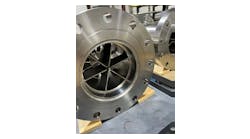The world market for fabric filter systems in 2010 will be down by 11 percent and will not recover until 2012, according to a report by the McIlvaine Company (www.mcilvainecompany.com). McIlvaine predicts overall sales will remain high in 2009, as many orders are already booked but not yet recognized as revenue. However, McIlvaine says revenue in the steel and cement segment will be down significantly in 2009, while economic stimulus efforts in the United States and China figure to have a longer-term positive impact in both segments.
The outlook for the replacement bags is brighter, according to McIlvaine, as sales are expected to increase slightly in 2010 and continue to grow in 2011 and 2012.
| 2005 1,856 2,423 5,331 |
2006 1,964 2,633 5,792 |
2007 2,087 2,864 6,301 |
2008 2,211 3,218 7,080 |
2009 2,223 3,464 7,621 |
2010 2,297 3,100 6,820 |
2011 2,389 3,085 6,787 |
2012 2,486 3,383 7,442 |
Power, cement, steel and asphalt will remain the four largest applications, according to McIlvaine, which sees the replacement of precipitators with fabric filters as a continuing trend in the power industry despite the world recession. Meanwhile, the U.S. power industry is installing fabric filters to help in mercury capture, as well as installing dry flue gas desulfurization systems, which use fabric filters to capture the gypsum formed in the dry scrubbers.
In 2010, McIlvaine says Asia will spend 50 percent more for fabric filter systems than the Americas and more than two and a half times as much as Europe. Sales of systems in Europe in 2010 will be off by 30 percent from the 2008 level, as carbon trading and the generally slow economy are resulting in a slowdown in this area. The companies participating in the industry can be segmented into raw materials (resins), fibers, roll goods, bags and equipment.
The United States remains a leader in the production of fabric filter equipment, but a number of Chinese companies are entering the marketplace as well. Meanwhile, Europe is a leader in the roll goods and fiber categories.
Much of the recent innovation has been in the development of roll goods, according to McIlvaine, as membranes with non-woven backing have gained market share over conventional non-wovens. Meanwhile, McIlvaine says nanofibers are creating higher efficiency with lower energy consumption.
For more on McIlvaine’s study, World Fabric Filter and Element Market, visit www.mcilvainecompany.com/brochures/air.html#n021.

